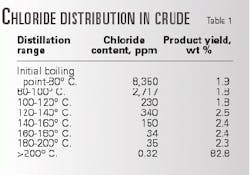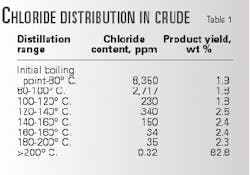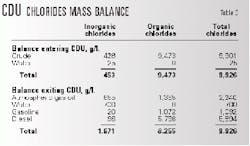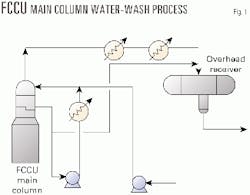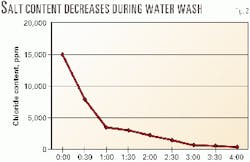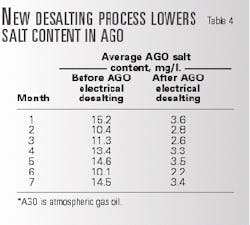Gas oil desalting reduces chlorides in crude
A new atmospheric gas oil (AGO) electrical-desalting process reduced the amount of chlorides in the main fractionator of a Chinese fluid-catalytic cracking unit (FCCU).
Although desalting the crude before it enters the crude-distillation unit (CDU) removes some chlorides, the Sinopec Luoyang, China, petrochemical complex (LPC) found that adding a desalting step to the AGO improves FCCU operations.
Chloride problems
Chlorides in crude oil form areas of salt accumulation in processing units. These areas of accumulation seriously corrode key equipment, especially those that run in the low-temperature ranges in which hydrogen chloride forms.
The conventional method of removing chlorides is a combination of injecting ammonia into the top of CDU and using electrically desalted crude-oil feed.
Although this is generally effective, it does not satisfactorily remove chlorides. The chloride content in the crude oil increases sharply after the addition of a dewaxer, a solvent used to separate the wax from the crude oil, or some other chloride additive.
Even after conventional methods reduce the salt content in the crude oil, the salt content in the AGO is higher than the overall salt content of the crude oil. High salt content causes abnormal operations of the FCCU, which uses the AGO as feed.
Ammonium chloride deposits increase the pressure downstream of the main column, which prevents the overhead-tower streams and diesel from being drawn out. These operations in turn cause the operators to lose control of the end point of the gasoline in the overhead receiver.
Sinopec adopted an on-line water-wash system to dissolve some of the salts in the distillation column to maintain a smooth FCCU run. Although water washing can solve the problem temporarily, unit instability returns periodically when the salt accumulation reaches a certain level.
Before its new electrical desalting process, Sinopec water-washed the column up to 13 times/year. Water washing is not preferred because it raises unit-safety concerns and inefficiently uses money and manpower.
In response to these problems, Sinopec in 1998 developed and adopted electrical-desalting process for atmospheric heavy oils based on the crude oil electrical-desalting process. The new process eliminates problems associated with chlorides in the FCCU.
Distribution in the raw oil
Chlorides exist in crude oil in two forms: organic chloro-hydrocarbon and inorganic chloride (such as compounds of magnesium and sodium). Conventional electrical desalting processes can usually remove inorganic chlorides in the raw oil that accumulate in the water phase.
Crude oils have varying salt distributions. A typical distribution is 75% NaCl, 10% CaCl2, and 15% MgCl2.
The content of organic chloro-hydrocarbon in crude oils is somewhat low. Thus, the content of NaCl mainly controls the amount of the chloride content in the raw oil.
Sinopec's LPC carried out tracing investigations to analyze the chloride distribution in the crude oil. Table 1 shows the results.
Table 2 shows that the salt distribution of the same crude oil in three different samples is different.
The crude oil requires the addition of an organic chloride dewaxer to maximize the amount of raw crude extracted from the wax. Organic chloride is difficult to remove using the crude-oil electrical desalting process.
Chlorides balance
When Sinopec LPC observes that the chloride content in the crude oil is increasing, it adjusts the crude-oil electrical-desalting process. The refinery controls the salt content in the crude oil below 4 mg of chlorides/l. of oil (mg/l.), which conforms to the quality-control standard and meets the requirement of FCCU feed.
The salt content in the AGO entering the FCCU, however, is still very high. A chloride balance analysis of the CDU shows that the salt content in the crude oil increases after the CDU; after which time, the chloride level becomes unbalanced.
In practice, Sinopec's salt-content analysis measures the amount of free chlorine ions, which is soluble in the water (becomes NaCl content). The organic chloride compound cannot be measured, however, because it is not in free form.
Thus, although the analysis shows that the chloride content from a draw in the CDU is higher than that from the CDU feed, in reality, the total chlorides are balanced (Table 3).
The organic chloride content decreases while the inorganic chloride increases after the distillation. The increased inorganic chlorides enter the FCCU along with the AGO and cause abnormal operation of the main column.
Chloride buildup
The mechanism of the buildup of chloride content consists of two hydrating processes. One is the hydration of organic chlorides; the other is the hydration of inorganic chlorides.
Of the two hydration processes, the organic hydrated chloride is responsible for most of the increase in crude-oil chloride content (see box).
Insoluble inorganic chlorides are difficult to remove during the crude-oil electrical-desalting process. When the temperature of the crude oil and the AGO in the CDU increases, however, the hydration rate speeds up rapidly, and the inorganic chlorides hydrate into free chlorine ion (see box).
From the CDU, the anhydrate inorganic and organic chlorides enter the FCCU, where more hydration occurs and more chlorides are produced. These chlorides eventually contribute to a large amount of HCl, which can seriously damage the unit.
Salt accumulation
Nitrogen in the FCCU feed will produce ammonia (NH3) during the FCCU process. The NH3 and HCl react to form NH4Cl, which is highly soluble in water.
At 137.8° C., NH4Cl turns back into NH3 and HCl. At cooler temperatures, however, it becomes solid NH4Cl particles.
Tiny NH4Cl particles accumulate on the top of the main column. They dissolve in the low-temperature water phase and go downstream along with the internal recycled oil. As the temperature increases, the NH4Cl solvent loses water and condenses into a semi-fluid with a high viscosity.
Mixed with rust and catalyst powder that have settled in the downcomers, this liquid handicaps flow, increasing the delta pressure (DP) of the main column. In the end, it will cause abnormal unit operations.Column water-washing
The unit exhibits several distinct symptoms when salt accumulates in the main column. The DP of the main column increases by 20-50 kPa. The light cycle oil (LCO) draw cannot be drawn out. The temperature on the top of the column goes out of control, and the diesel cut rushes to the top, throwing off its product quality.To keep the unit running, refiners often perform an on-line water wash of the main column as an emergency troubleshooting measure.
Fig. 1 shows the flow of the water wash.
After the water enters the top of the column, operators monitor the salt content on the effluent drain point to make sure that the water-wash is dissolving the salts and to determine when to end the wash.
Fig. 2 shows the typical trend of chloride content during a water wash, which decreases over time.
Refiners should heed the following tips for water-washing:
- Control the temperature on the top of the column, making sure that the steam can condense into water.
- Control the temperature in the middle portion of the column to prevent water from dropping to the bottom of the column. The water should stay in the middle of the column. Water movement to the bottom will rapidly increase the pressure of the reactor, damaging the unit.
- Guarantee that the flash point and the end point of the LCO is on-specification.
AGO electrical desalting
Sinopec's new process for AGO electrical desalting is really a second-stage electrical desalting of the CDU heavy oil. The process removes the inorganic salts produced in the CDU.
The new heavy-oil desalting process is different from the crude-oil desalter in several ways:
- Process temperature is higher.
- It requires a proper demulsifier.
- Feed-water volume is higher.
The development and application of this new process eliminates the possibility of incremental AGO salt content caused by organic chloride hydration. The result is effective control of the chloride content in the FCCU feed.
Before Sinopec adopted the new process, it water washed the main column once a month. With the new process, the refinery seldom washes it.
Table 4 shows the salt content in the AGO before and after the application of the new electrical-desalting process. In this 7-month period, the AGO salt content decreased by about 75%.
The new system saves the refinery about $2.4 million/year. The total cost (including labor, material, and downtime) of each main column water-wash is $300,000.
There is an added social benefit to elimination of water washing. Water washing sharply increases the amount of pollutants in the wastewater, which increases the potential of unintentional environment pollution.
The author
Xiaodong Ye is the FCC manager and a senior engineer at Sinopec's Luoyang petrochemical complex. He currently develops optimization software packages and computer simulations for the refinery. Ye has more than 12 years of experience in FCCU operation and processing design. He holds a BS in chemistry from Lanzhou University, Lanzhou, Gansu, China.
